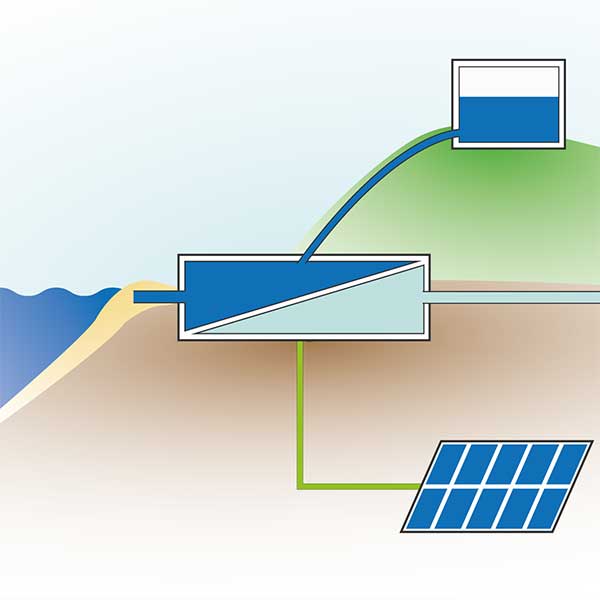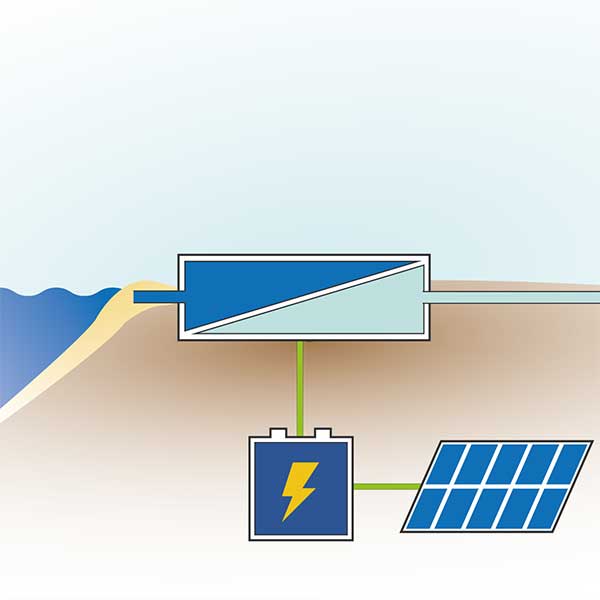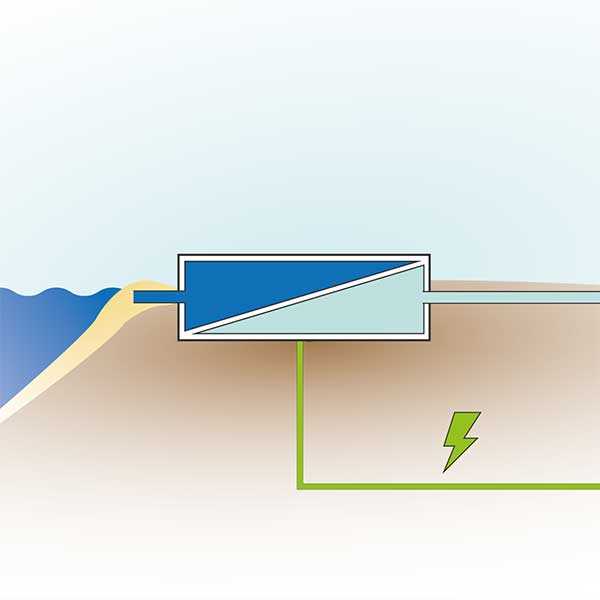SELECT YOUR SITUATION
Create water for only 1.3 $/m³ or 5.0 $ per 1,000 gallons:

Elevation?
Let nature do the work- Solar energy water maker using gravity from a hill
- 24/7 independent water supply

Flat?
Works everywhere- Solar energy water maker using battery storage
- Independent water supply without elevation

Already green?
Efficient water maker- Efficient water maker using your electricity
- When green or affordable energy is already available
AFFORDABLE WITHOUT EMISSIONS

TDS: Seawater 35,000 ppm, Brackish water 5,000 ppm
Cost of Water
Includes the investment costs to have a turn-key installation, consisting of the engineering, components, transporation, installation and training for operation. Also included are the operational costs for 15 years. Excluding possible required civil works and cost of land.
CO2 Emissions avoided
Cumulative emissions over 15 years using 0.00069 metric tons CO2 per kWh, taken from US Environmental Protection Agency 2014, eGRID, US annual non-baseload CO2 output emission rate Assuming a small scale RO power consumption of 3 kWh/m³ for brackish water and 8 kWh/m³ for seawater
ELEVATION: LET NATURE DO THE WORK
We turn seawater or brackish water into affordable fresh water 24 hours a day, without the use of expensive energy from the grid. Our efficient solution uses solar, wind or wave energy directly to fill up a water buffer installed at a hill with seawater. Through the force of gravity, the reverse osmosis process receives its required feed: pressurized seawater. We make sure the water buffer always contains water to enable constant water production, resulting in lowest cost. The waste energy of the reverse osmosis process is re-used to reduce the required elevation with 80% to 90 m or 290 ft for seawater. Take a look at the video & explore the working principle by clicking different components in the figure. We use the forces of nature at its best for an independent guilt-free water supply. By avoiding energy conversion losses, batteries & frequent maintenance, we offer savings up to 70%. The bigger, the better, as water cost come down with size of supply. Sizes start small and go up to millions of liters per day. Turn your water supply into an enriching experience for the people, planet and your profit.
THE SOLUTION EXPLAINED

Renewable sources as the sun, wind or waves are the only sources of energy used
Either PV panels or wind turbines or wave energy can be utilized, or a combination hereof, depending on the local situation. The footprint is determined by the source water salinity and the daily required fresh water production. The renewable energy sources will be placed at a suitable location of your preference. When renewable energy is available, the energy is directly converted into water displacement by the pump. There is no electricity source required, making the system suitable for off-grid applications.

A salt water source intake will be realized
The source water intake can be realized through a beach well, open ocean intake or borehole. During the design process, we make sure to avoid visual impact and disturbances of the marine environment.

The pump and controller directly utilize the renewable energy available
The salt-water resistant pump displaces the source water towards the elevated water buffer and the reverse osmosis process. Through the combination of the controller and pump, the energy generated by the renewable energy source is very efficiently converted into pumping motion. The pump speed varies depending on the availability of the renewable energy source. It requires no auxiliary energy source and is very low on maintenance.

One pipe installed out of sight connects the components
The pump, elevated water buffer and water treatment plant are connected through one pipeline. Part of the displaced water flows to the elevated water buffer, to cover the periods lacking renewable energy sources. When renewable energy sources are not available, meaning there is no pumping motion, the flow automatically reverses direction by gravity. A constant flow of salt water travels to the water treatment plant. The size of the pipeline depends on the daily required fresh water production. Friction losses are negligible by using smooth pipes, either of HDPE or PVC. This means that it is possible to cover large distances between the pump, elevated water buffer and water treatment plant. The piping can be placed underground to avoid visual impact and will be arranged according to your preference.

The elevated water buffer enables efficient and constant operation
The salt water, which is displaced upwards in periods with sufficient renewable energy sources, is stored inside the elevated water buffer. For periods with limited renewable energy sources, in case of solar panels when thick clouds cover the panels or during the nights, the water buffer will provide the required pressure to drive the water treatment. The elevated buffer can be created as a corrugated galvanized steel tank, including a bladder lining, suitable for coastal environments. An alternative is to create a cistern tank of concrete suitable for salt water storage in any dimension. By customized solutions, it is possible to limit the area required to realize this form of energy storage. Unlike batteries, the water buffer has a long lifetime and does not involve energy conversion losses. The elevation difference required between the water treatment plant and the elevated water buffer is determined by the source water salinity. For seawater with a Total Dissolved Solids (TDS) value of 35.000 ppm, approximately 90 meters ≈ 295 feet is required. For brackish water with a TDS value of 5.000 ppm, approximately 50 meters ≈ 165 feet is required.

Proper pre-filtration results in longer lifetime of the desalination plant
To remove large particles, cartridge filtration will be used. Additional pre-filtration might be required, depending on the source water quality and the source water intake. Optimal pre-filtration design will maximize the lifetime of the reverse osmosis membranes and ensure proper fresh water production.

High quality fresh water is the result of the reverse osmosis process
The Reverse Osmosis (RO) process removes all salts, contaminants, viruses, bacteria, cysts etc. down to a size of 0.0001 micron without requiring chemical treatment. The reverse osmosis filtration technology is based on a multi-layer membrane which filters the water under high water pressure. The technology is suitable for seawater and brackish (ground) water and works by applying pressure on the saline water in the semi-permeable membrane. This pressure is delivered by the energy recovery device. The reverse osmosis process has two exit flows: one containing the fresh water and the other containing the slightly salter water. This concentrated flow is still under 97% of the working pressure. The pressure of the concentrated flow is re-used by the energy recovery device to reduce the required amount of elevation significantly. Because of the elevated water buffer the reverse osmosis process will constantly produce freshwater. This constant operation expands the membrane lifetime considerably.

Post-treatment will be included depending on the intended water use
The fresh water flows towards the fresh water storage tank. In between it can be post-treated when required. The water can be re-mineralized to increase the water quality and the water can be made suitable for lengthy periods of storage.

Energy recovery reuses the excess energy and reduces the required elevation
The pressure of the concentrated flow of water is used to increase the pressure of the incoming flow of salt water going towards the reverse osmosis process. By combining the pressure of the elevated water tank and of the concentrate flow, sufficient pressure will be delivered to purify the saline water. The combination of the energy recovery device and reverse osmosis process ensures a constant production of fresh water. The energy recovery device does not require any auxiliary energy and is a pure mechanical device.

The fresh water will be stored and connected to the distribution system
The produced fresh water is ready to be used directly. As water demand usually fluctuates, the water can be delivered into a fresh water storage which is connected to the distribution system. The fresh water can also be transported over large distances to reach the end-user. Depending on the intended use of the water, we can make sure it will meet all quality requirements.
FLAT: WORKS EVERYWHERE
Many properties are restricted in size and have limited access to elevation. To enjoy a reliable independent water supply, we have developed a solution that works everywhere. A combination of state-of-the-art solar energy and battery technology allows efficient reverse osmosis operation, while limiting the required battery size. All components can be integrated at preferred locations, to avoid impact on existing infrastructure and limit the required footprint. The high efficiency reverse osmosis is equiped with remote monitoring and designed for easy operation. All components are purpose built to survive corrosive environments and allow a long life-time. To realize lowest cost of water, the sizes of the solar energy, battery bank and reverse osmosis units are optimzed during the design phase. A grid-tied back-up can be included and the solution is offered from a few m³ up to millions of liters of potable water supply per day. Make sure to leave your contact details to enjoy affordable water from unlimited resources.

ALREADY GREEN: EFFICIENT SUPPLY
We understand that water and energy are not always considered at the same time. If you already enjoy renewable energy or currently have an affordable energy solution in place, we can be your partner for the water supply. Especially for small-scale solutions, energy efficiency is usually lacking. We offer high-efficient reverse osmosis units that run below 3 kWh/m³ or 11 kWh/1,000 gallons energy consumption for seawater desalination, starting already at a few m³ or 1,000 gallons per day and going up to much bigger sizes! Just like all our solutions, water cost can be as low as 1.3 $/m³ or 5.0 $ per 1,000 gallons. Because of our experience in remote regions, we value the need for ease of operation & maintenance and can tailor the installation services to your needs. GSM based remote monitoring and control is included and all components are purpose built to survive corrosive environments. Join the resorts, private properties, communities & municipalities who have already made this step to independence. Why? Because we believe that a reliable access to safe and affordable water is of utmost importance.
